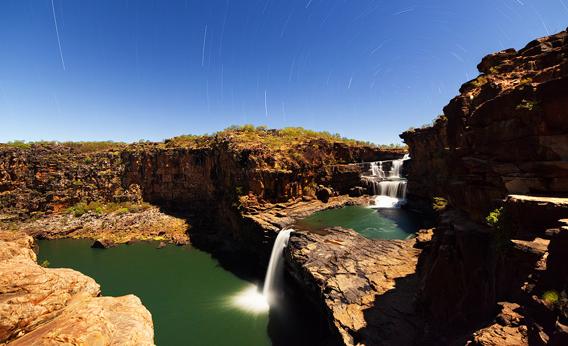Create a free profile to get unlimited access to exclusive videos, sweepstakes, and more!
Tricky Astrophoto: Is It Day or Night?

Mike Salway is an astrophotographer with a keen eye. I featured his lovely photo of the Milky Way over Australiaâs Bungle Bungles recently, so when he contacted me again with a new picture, of course I was interested. Then I saw it and laughed out loud.
Let me ask you: In this picture of Mitchell Falls, is it daytime or nighttime?
It looks like day, right? But there are stars in the sky! How can this be?
The Moon, thatâs how this can be. The photo was taken at night; in fact it was at midnight. On July 3, 2012, when Salway took the picture, the Moon was just a couple of days past full and nearly overhead. Standing there on the rocks overlooking the falls, the scene would have been easily visible by moonlight, though the sky would look mostly dark, with a few dozen stars visible.
But to the camera, especially in a time exposure, the moonlight adds up. It lit the ground, making it look like day. Not only that, but the air scatters blue light from the Moon just as it does from the Sunâafter all, moonlight is just reflected sunlightâso the sky looks blue. Even so, the stars can be seen, diminished but still leaving their marks. The picture above is actually a stack (literally, adding the pictures together) of four pictures: three taken for 15 minutes at a narrow aperture setting (to get the stars), and one wide-open aperture shot for 15 seconds (to see the lit foreground and the falls). The only real manipulation of the picture was to use a mask to bring out the foreground better.
The result is lovely. I like how the shorter exposure is long enough to blur out the water motion but still short enough to show spiky fans of water blasting from the bottom of the falls. I also like how the wide-angle (14 mm) lens distorts the star trails into ovals. Note the lack of a pole star: This was shot in northwest Australia, and in the Southern Hemisphere there is no star near the celestial pole like we have up here. Thatâs a pretty good giveaway that youâre seeing a picture from below the equator.
Salway also created a time-lapse video of the scene that shows the shadows cast by the Moon creeping along the ground:
Itâs difficult to see the stars in the little patch of sky to the upper right, but if you add all the photos together they become obvious:
Tricky, isnât it? Cameras are interesting tools; they let us see things right in front of us that our eyes arenât capable of seeing. I am very commonly asked if some picture or another of an astronomical object is what our eyes would see if we were there. The answer is always ânoâ: Cameras never actually show what your eyes see. The use of a lens, of a digital detector, an aperture setting, an exposure time; these all change the picture seen by the camera, distorting reality in subtle ways. Itâs all real, but itâs a different way of seeing.
What you see is not always what you get. Or vice versa. But thatâs why we have tools that help us see what our eyes canât. And the results can be quite stunning and beautiful.


























